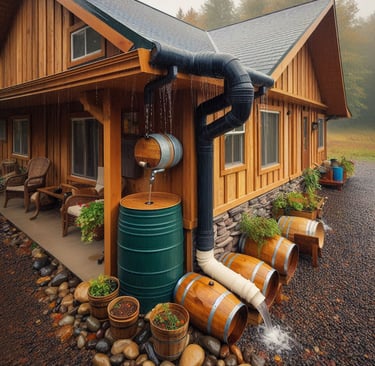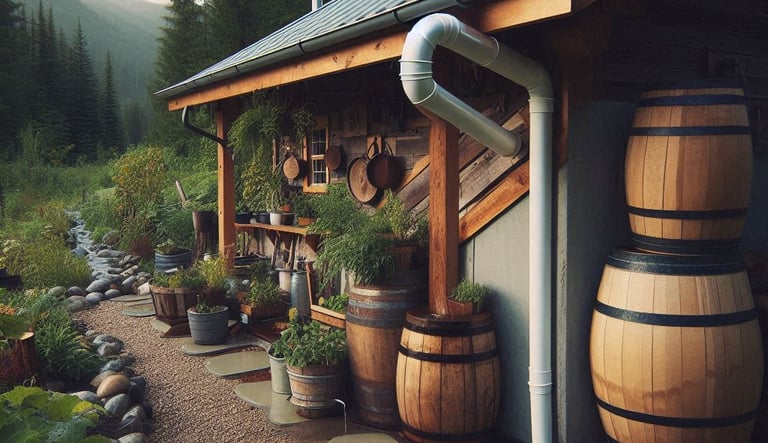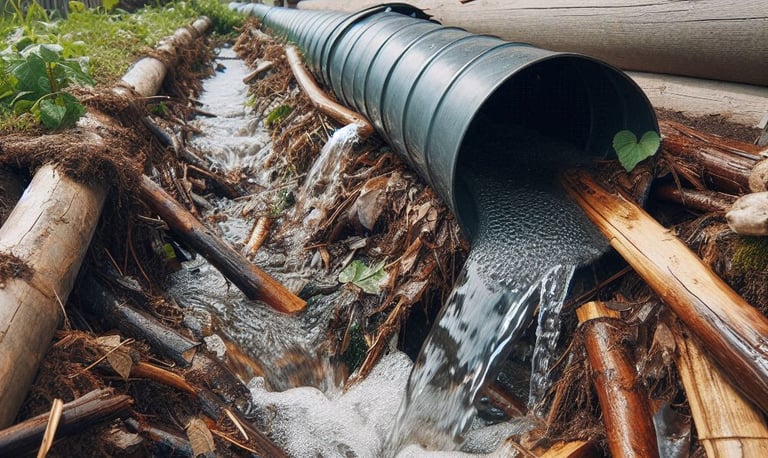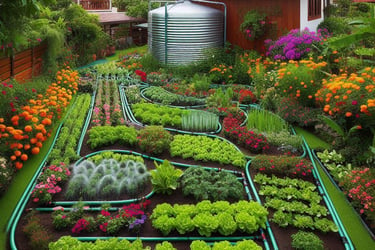Rainwater Harvesting 101: How to Collect and Use Rainwater on Your Homestead
Learn how to harvest rainwater effectively with our step-by-step guide. Discover sustainable techniques to collect, store, and use rainwater, perfect for eco-conscious homesteaders and gardeners.
HOMESTEADING
Kathrine-Anne Hill
8/21/20249 min read


Introduction to Rainwater Harvesting
Rainwater harvesting is an essential practice for homesteaders looking to innovate their water usage strategies. It involves the collection and storage of rainwater from surfaces such as rooftops, which can then be used for a variety of purposes. This practice not only alleviates dependence on municipal water systems but also offers a sustainable approach to water management. Given the increasing frequency of droughts and the escalating costs of water, rainwater harvesting stands out as an economically viable and environmentally friendly solution.
One of the primary benefits of rainwater harvesting is its contribution to water conservation. By capturing and utilizing rainwater, homesteaders can significantly reduce the strain on local water supplies. This is particularly advantageous in regions suffering from water scarcity. Moreover, the use of harvested rainwater can lead to substantial reductions in water bills, as less reliance is placed on treated water sources provided by municipal systems. Financial savings can be amplified over time, making rainwater harvesting a cost-effective strategy.
Beyond cost savings and water conservation, rainwater harvesting offers an invaluable alternative water source during periods of drought. As climate change continues to impact weather patterns, ensuring access to an independent water supply can mean the difference between thriving and merely surviving during dry spells. Harvested rainwater can be used for various non-potable needs such as irrigation, flushing toilets, and even some cleaning tasks. It can also be processed for potable uses, providing a comprehensive backup supply for households.
Understanding the importance and benefits of rainwater harvesting provides a solid foundation for homesteaders seeking to adopt this practice. It not only enhances water security but also supports sustainable living practices that benefit both the individual and the environment. As we delve deeper into the specifics of collecting and using rainwater, it becomes clear that rainwater harvesting holds a vital place in any homesteader's toolkit.
Understanding the Basic Components
Rainwater harvesting systems rely on a series of interconnected components working in tandem to collect, filter, store, and distribute rainwater efficiently. Understanding these essential components is crucial for anyone looking to establish a functional rainwater harvesting setup on their homestead.
The catchment area is the initial point of contact in a rainwater harvesting system, often consisting of rooftops. The roof surface captures rainfall and directs it towards the next stage. It is vital to ensure the material of the catchment area is non-toxic and suitable for potable water if the harvested rainwater is intended for consumption. Common materials include metal, clay, and certain types of asphalt shingles.
Gutters and downspouts form the conveyance network, guiding the collected water from the catchment area to the filtration and storage systems. Installation of properly sloped and adequately sized gutters ensures efficient water flow, while downspouts facilitate the directed movement of harvested rainwater. Mesh screens and leaf guards integrated within gutters are useful for preventing debris and pests from entering the system.
The filtration system is critical for ensuring the collected rainwater is clean and safe for use. Initial filters like first-flush diverters remove the first few gallons of collected rainwater, eliminating potential contaminants such as dirt or bird droppings. Subsequent filtration stages, including sediment filters and carbon filters, further purify the rainwater, making it suitable for various uses within the homestead.
Storage tanks or cisterns are essential for holding the filtered rainwater. These tanks need to be durable, UV-resistant, and of sufficient capacity to accommodate the volume of water required. Storage options can range from above-ground polyethylene tanks to underground concrete cisterns, depending on space availability and aesthetic preferences.
Finally, the distribution system enables the utilization of stored rainwater. Pumps and gravity-fed systems are typical methods for distributing water from storage tanks to its point of use. Efficient distribution ensures that the harvested rainwater meets the homestead's needs, whether for irrigation, washing, or potable uses.
By understanding the functions and interconnections of these components, homestead owners can design and implement an effective rainwater harvesting system that maximizes water conservation and promotes sustainability.
Planning Your Rainwater Harvesting System
When planning a rainwater harvesting system for your homestead, several factors must be considered to ensure efficiency and sustainability. The first step in designing your system is to calculate the water needs of your homestead. This includes household usage, irrigation for gardens, and water for livestock. Understanding your water demand will guide you in determining the necessary storage capacity and infrastructure.
Next, assess your local rainfall patterns. Look up historical rainfall data for your area, which is often available from local meteorological agencies or online databases. By understanding the frequency and volume of rainfall, you can estimate how much rainwater you can potentially collect. For instance, in areas with higher rainfall, smaller storage tanks might suffice, whereas arid regions require larger tanks to store sporadically abundant rainwater.
Roof size is another critical aspect of your rainwater harvesting plan. Calculate your roof's catchment area by measuring the length and width of the roof surface where rainwater will be collected. Multiply these dimensions to determine the square footage. To estimate the volume of water you can harvest, use the following formula: 1 inch of rain on a 1,000-square-foot roof yields about 623 gallons of water. Adjust the formula based on your specific dimensions and rainfall data.
Choosing the right storage tank is pivotal to your system's success. Tanks range from small barrels to large cisterns, with materials such as plastic, metal, and concrete available. Ensure the tank size matches your calculated storage needs while considering potential future expansions. Proper tank positioning is also essential; it should be placed in an accessible location, ideally elevated for gravity-fed distribution.
Lastly, familiarize yourself with local regulations and permit requirements. Some jurisdictions have specific codes for rainwater harvesting systems to ensure water safety and system reliability. Consulting local authorities and obtaining necessary permits will prevent legal complications and facilitate a well-regulated setup.
Incorporating these considerations into your rainwater harvesting plan will set the foundation for an efficient and effective system tailored to your homestead’s unique needs.
Installation and Setup Guide
The installation of a rainwater harvesting system involves several crucial steps to ensure efficient collection and usage of rainwater. Begin by installing gutters on the roof to capture rainwater. Ensure the gutters are sloped correctly to direct water toward downspouts. Downspouts, connected to the gutters, must be properly sealed to prevent leaks and channeled to the first-flush diverter. The diverter's role is key in directing the initial runoff away from the storage system, thus preventing debris and contaminants from entering the system.
Next, install a filtration unit to remove any remaining debris from the water. This unit should be placed between the first-flush diverter and the storage tank. Filters vary based on system complexity, but even a basic mesh filter can significantly enhance water quality. Consider using multiple stages of filtration for better results.
The heart of the system, the storage tank, can be above or below ground based on your needs and space availability. Ensure the tank is durable, resistant to sunlight, and has a tight lid to prevent contamination and mosquito breeding. Position the tank to maximize gravity flow for water distribution if using a gravity-fed system. If relying on a pump, the tank's placement is less critical but consider energy efficiency and ease of maintenance.
Distribution systems can range from simple gravity-fed systems to complex ones with pumps and automated controls. Gravity-fed systems require elevated tanks and rely on natural water flow, while pumped systems need electrical connections and backflow prevention fittings to maintain water pressure and hygiene. Automated systems often incorporate timers and sensors for efficient water use.
Essential tools for this installation include a tape measure, drill, gutter sealant, hacksaw, Teflon tape, and basic plumbing tools. Safety precautions are paramount—wear gloves and safety goggles when handling tools and installing components. Moreover, working on rooftops necessitates caution; use proper harnessing to prevent accidents.
Potential challenges include sealing leaks, maintaining filtration units, and preventing algae growth in the storage tank. Regular inspection and maintenance can mitigate these challenges, ensuring the system operates efficiently. By following these guidelines, you can set up a reliable rainwater harvesting system to sustainably manage and utilize rainwater on your homestead.
🛍️ 16-Piece Rainwater Harvesting Kit, Easy Installation Durable Downspout Connector with Adjustable Length, Corrosion-Resistant for Home Roof Rainwater Collection Systems🎉 Coupon price[CA$19.86👉 item link: https://temu.to/m/ut5l2oz7e77
⭐️Click the link https://temu.to/m/uea3cjokc4a to get 💰CA$100 coupon bundle or ⭐️ Search acd975411 on the Temu App to get 💰30% off discount !!
Maintenance and Troubleshooting
Proper maintenance of a rainwater harvesting system is crucial to ensure its long-term functionality and efficiency. Regular cleaning schedules form the backbone of these practices. Gutters, being the initial catchment point, should be inspected and cleared of debris such as leaves and dirt on a monthly basis. This prevents clogging and ensures free flow of water to the collection system.
Filters play a significant role in maintaining water purity. Filters should be checked and cleaned every three months to prevent the accumulation of sediments and organic matter. For households using fine mesh filters, a monthly inspection might be necessary, especially during the fall when debris can be more abundant.
Storage tanks require semi-annual maintenance to prevent algae growth. If placed in direct sunlight, using opaque tanks can limit light penetration and thus inhibit algae. However, in circumstances where algae growth is observed, a diluted bleach solution or commercially available algaecides can be used to clean the tanks. Additionally, consider periodic tank dewatering and cleaning every couple of years, depending on the rate of sediment accumulation.
Preventing freezing in colder climates is paramount. Insulating above-ground components such as pipes and tanks effectively mitigates the risk. Further precaution can be taken by disconnecting and draining the system before the onset of freeze conditions, thereby avoiding damage.
Despite meticulous maintenance, troubleshooting remains an integral part of rainwater harvesting systems. Addressing leaks promptly is crucial. Regularly inspect all joints, seals, and connections for wear and tear. Use appropriate sealants or replace faulty parts to prevent water loss. Low water pressure can often result from clogged pipes or filters, which necessitates regular checks and cleaning as a countermeasure.
Contamination is another potential issue. Conduct water quality tests periodically to identify harmful bacteria or pollutants. Employing UV sterilizers or boiling water can be effective in ensuring its safety for household use. By adhering to a stringent maintenance schedule and proactive troubleshooting, one can optimize the benefits of rainwater harvesting systems efficiently.
Utilizing Harvested Rainwater
Harvested rainwater presents multiple opportunities to enhance sustainability on your homestead. One of the most common applications is in gardening and irrigation. By directly channeling collected rainwater to your garden, you can ensure a consistent supply of water to nourish plants, especially during dry spells. This method is highly efficient as it reduces dependence on municipal water supplies and can significantly cut down costs. Moreover, utilizing rainwater for irrigation encourages more organic practices by minimizing the risk of contaminants that are often found in treated water.
Another indispensable use for harvested rainwater is in livestock management. Providing animals with natural rainwater can lead to improved health, as it often contains fewer chemicals compared to tap water. Rainwater can be directly funneled into troughs or reservoirs designed specifically for livestock consumption.
Harvested rainwater is also suitable for various household cleaning purposes. It can be utilized for flushing toilets, washing clothes, and general cleaning tasks around the home. This application not only conserves potable water but also can help in reducing the overall water bill.
For those considering making rainwater drinkable, it is crucial to implement a rigorous purification process. While rainwater is relatively pure when it falls from the sky, it can pick up contaminants as it travels across surfaces into collection systems. Filtration and purification are therefore essential if the water is to be used for drinking. Methods such as carbon filtering, UV sterilization, and boiling can be employed to ensure the water's safety.
Nonetheless, it’s important to acknowledge that specific treatment methods may be required depending on the use. For example, water intended for irrigation might not need as extensive purification compared to water meant for drinking. Responsible and efficient use of harvested rainwater requires planning and appropriate treatment to maximize benefits while safeguarding health.
Embracing rainwater harvesting not only promotes ecological balance but also fosters a self-sufficient and resilient lifestyle on your homestead. Properly utilizing harvested rainwater helps to ensure that essential resources are maintained, ultimately contributing to a sustainable future.













